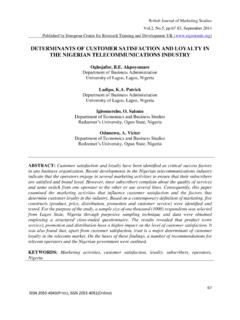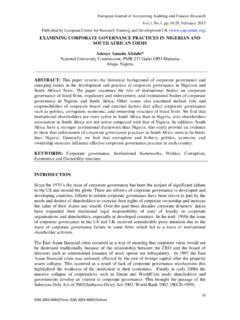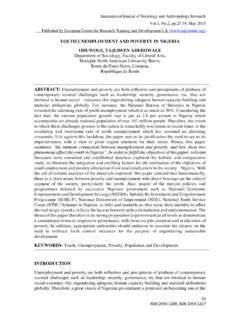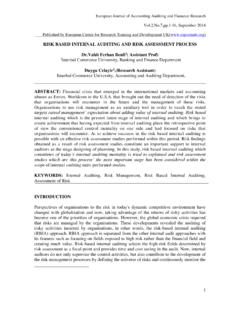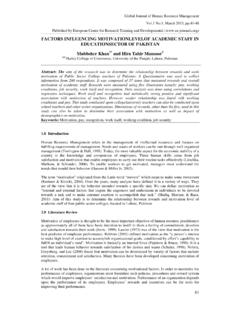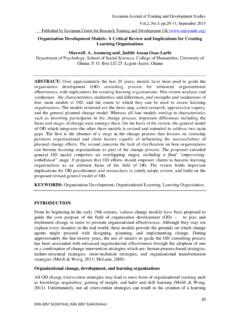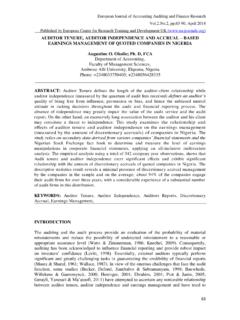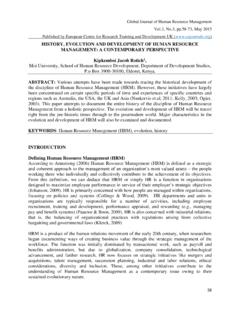Transcription of CHALLENGES AND BARRIERS ENCOUNTERED BY THE SMES …
1 International Journal of Small Business and Entrepreneurship Research , , September 2014. Published by European Centre for Research Training and Development UK ( ). CHALLENGES AND BARRIERS ENCOUNTERED BY THE SMES OWNERS IN. MUSCAT. Blossom Christina *. Assistant Professor Department Of Management Waljat College Of Appleid Science, Muscat :197, , RUSAYL, SULTANATE OF OMAN. Aslam Neelufer**. Assistant Professor Department Of Management Waljat College Of Appleid Science, Muscat Said Al Amri **. Emba Student Department Of Management Waljat College Of Appleid Science, Muscat ABSTRACT: Small and Medium Enterprises (SMEs) plays a decisive role in any developing economy.
2 In Oman about 60 percent of the SMEs are the source of employment. Although there is an increase in the SMEs but there is also innumerable CHALLENGES associated with the growth, this research paper explores the specific CHALLENGES ENCOUNTERED by the SME owners. In this study simple random sampling was adopted with the data sample size of 35 SME owners and the data was collected with the help of structured questionnaire. The data was further analyzed by using descriptive statistics and ANOVA and represented through tables. It was found that the majority of SMEs face CHALLENGES in the form of policy and administrative CHALLENGES followed by the marketing and financial issues.
3 It is suggested that the SMEs directorate should form a committee to prepare the SME framework, the rules and regulations associated towards that to avoid cumbersome policies and complexities for those who would prefer registering the business legally. KEYWORDS: CHALLENGES , Directorates, Framework, Small and Medium-Enterprises (SMEs). INTRODUCTION. The governments of developed as well as developing countries have acknowledged the reality that Small and Medium Enterprises (SMEs) form the nucleus of any economy. Green, (2003). There is an universal agreement on their major participation to the economic growth, employment creation, social cohesion, poverty alleviation and local and regional development.
4 SMEs are the largest group of enterprises in any economy. According to Matlay, H Westhead, P, (2005), SMEs make significant contributions to the socio-economic and political environment of most developed and developing nations as well 1. International Journal of Small Business and Entrepreneurship Research , , September 2014. Published by European Centre for Research Training and Development UK ( ). as to countries that are in progression from a command economy to market economy . Healthy and growing SME sector is considered to be important in obtaining sustainable competitive advantage and economic development at local, regional, and national levels.
5 According to United Nations Industrial Development Organization (UNIDO) approximates SMEs consist of more than 90% of all enterprises in the world and on an average are accountable for 80 to 90% percent of total employment. In the whole of Asia Pacific, more than 95% of companies are in SMEs sector, Japan 99%, Singapore , Malaysia 96% etc Koshy,P, (2007). Experts believe that good management, strong leadership, skilled work and innovation are among the major forces that contribute to the success of this vital sector. Ozgulbas et al, (2006) Despite that the SMEs are playing a positive role in the developing countries through creating job opportunities for all the social classes in the community specially the entrepreneur persons which will contribute in increasing the personal income level and a achieving the self satisfaction partially for some goods and service necessary for the community, in addition contribution in solving the poverty and who are looking for work problem.
6 Also these projects distinguished from the large firms by the low investment size which reduce its risk, beside that it consider as a good sphere to develop the managerial, technical, productivity, and marketing skills, and open a fertile scope for entrepreneurial individual initiatives, and enhance the self depending culture, to the extent that reduce pressure on the public sector at creating new job opportunities. OCCI, (2006), SMEs are vital in developing countries, for the economic growth and development. SMEs, through entrepreneurship helps the process of economic development, fosters economic growth, generate employment, and reduces rural unemployment and migration.
7 SMEs: Definition and Relevance The concept of SMEs is dynamic and relative Otokiti, (1985); Olorunshola,J. A, (2004);. Ogunleye, (2004). There is no universal definition for SMES as it varies from country to country. SMEs are normally categorized by the number of employees or by the worth of their total assets and by their turnover. The size-classification varies between different countries and there is no universal agreement in their definitions. The definition of small and medium industries differs from one country to another. It is easy to describe SMEs but difficult to give them a unified definition which is acceptable at international or even regional level due to the differences in the social and economic structures of the each country, as well as the differences in the criteria determining the basics of the enterprises such as: the statistical data used in the definition.
8 Due to lack of data, the definition of SME will remain mixed. Table 1. Definition of SMEs by number of employees and annual turnover in Oman 2. International Journal of Small Business and Entrepreneurship Research , , September 2014. Published by European Centre for Research Training and Development UK ( ). Oman Tender Board No. of employees Annual Turnover Small Up to 15 100,000 RO. Medium size (Grade 1) Up to 250 1,000,000 OR. Medium size (Grade 2) Up to 100 500,000 OR. Medium enterprises (Grade over 250. 1,000,000 OR. Excellent) employees Ministry of Commerce & Industry No. of employees Annual Turnover < 25,000 OR.
9 Micro Enterprises 0-5. (about $ 65,000). <25,000-2,50,00 OR. Small Enterprises 6-20. (about $ 6,50,000). <2,50, million Medium Enterprises 21-100 OR. (about $ million). Source: Ministry of Commerce and Industry, 2011. Among these institutions, the definition of SMEs offered by Oman Tender Board was adopted for this research work. The adoption of this definition is based on the fact that it is more comprehensive and categories the different grades of medium enterprises than others. Classification of Small and Medium Enterprises Luk cs, (2005), notes that the small and medium enterprises (SMEs) are constituted of a very heterogeneous group.
10 They may include a wide variety of firms from village handicraft makers, small machine shops, restaurants, and computer software firms that possess a wide range of sophistication and skills, and operate in very different markets and social environments. These SMEs normally operate in the formal sector of the economy, employ mainly wage-earning workers, and participate more fully in organized markets. Small and Medium-sized Enterprises (SMEs) are made up of a wide group of businesses in the trade, agro business, manufacturing, and service sectors. SMEs include a variety of firms that include village handicraft makers, small foundries, transport enterprises, whole-sale & retail businesses, hotels & restaurants, Cyber cafes, and software firms and they operate in the market environment, that differ in their degree of sophistication and skills.
